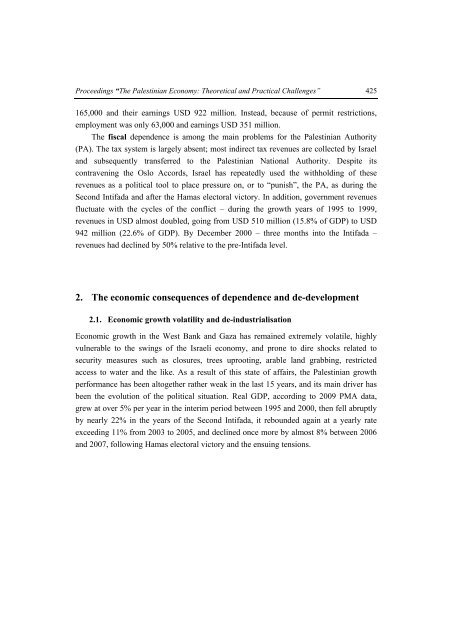The Palestinian Economy. Theoretical and Practical Challenges
The Palestinian Economy. Theoretical and Practical Challenges
The Palestinian Economy. Theoretical and Practical Challenges
Create successful ePaper yourself
Turn your PDF publications into a flip-book with our unique Google optimized e-Paper software.
Proceedings “<strong>The</strong> <strong>Palestinian</strong> <strong>Economy</strong>: <strong>The</strong>oretical <strong>and</strong> <strong>Practical</strong> <strong>Challenges</strong>” 425<br />
165,000 <strong>and</strong> their earnings USD 922 million. Instead, because of permit restrictions,<br />
employment was only 63,000 <strong>and</strong> earnings USD 351 million.<br />
<strong>The</strong> fiscal dependence is among the main problems for the <strong>Palestinian</strong> Authority<br />
(PA). <strong>The</strong> tax system is largely absent; most indirect tax revenues are collected by Israel<br />
<strong>and</strong> subsequently transferred to the <strong>Palestinian</strong> National Authority. Despite its<br />
contravening the Oslo Accords, Israel has repeatedly used the withholding of these<br />
revenues as a political tool to place pressure on, or to “punish”, the PA, as during the<br />
Second Intifada <strong>and</strong> after the Hamas electoral victory. In addition, government revenues<br />
fluctuate with the cycles of the conflict – during the growth years of 1995 to 1999,<br />
revenues in USD almost doubled, going from USD 510 million (15.8% of GDP) to USD<br />
942 million (22.6% of GDP). By December 2000 – three months into the Intifada –<br />
revenues had declined by 50% relative to the pre-Intifada level.<br />
2. <strong>The</strong> economic consequences of dependence <strong>and</strong> de-development<br />
2.1. Economic growth volatility <strong>and</strong> de-industrialisation<br />
Economic growth in the West Bank <strong>and</strong> Gaza has remained extremely volatile, highly<br />
vulnerable to the swings of the Israeli economy, <strong>and</strong> prone to dire shocks related to<br />
security measures such as closures, trees uprooting, arable l<strong>and</strong> grabbing, restricted<br />
access to water <strong>and</strong> the like. As a result of this state of affairs, the <strong>Palestinian</strong> growth<br />
performance has been altogether rather weak in the last 15 years, <strong>and</strong> its main driver has<br />
been the evolution of the political situation. Real GDP, according to 2009 PMA data,<br />
grew at over 5% per year in the interim period between 1995 <strong>and</strong> 2000, then fell abruptly<br />
by nearly 22% in the years of the Second Intifada, it rebounded again at a yearly rate<br />
exceeding 11% from 2003 to 2005, <strong>and</strong> declined once more by almost 8% between 2006<br />
<strong>and</strong> 2007, following Hamas electoral victory <strong>and</strong> the ensuing tensions.
















